You searched for: 厄瓜多尔谷歌开户投放【TG飞机:@bapingseo】马达加斯加谷歌排名【TG电报:@bapingseo】约旦霸屏优化【Telegram:@bapingseo】BET9─10年信誉亚洲第一品牌澳门六下彩网站?20220707Kn3fcw.html
<< Previous | Displaying results 176-200 of 369 for "厄瓜多尔谷歌开户投放【TG飞机:@bapingseo】马达加斯加谷歌排名【TG电报:@bapingseo】约旦霸屏优化【Telegram:@bapingseo】BET9─10年信誉亚洲第一品牌澳门六下彩网站?20220707Kn3fcw.html" | Next >>
-
Martha and Waitstill Sharp
ArticleMartha and Waitstill Sharp, American Unitarian aide workers, helped thousands of Jews, intellectuals, and children in Prague, Lisbon, and southern France in 1939–1940.
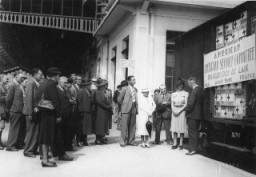
-
Railcar: Interior
ArtifactMany different kinds of railway cars were used for deportations. They varied in size and weight. The railway car on display in the United States Holocaust Memorial Museum's Permanent Exhibition is of just one type used. The dimensions of the railway car in the Museum's exhibition are as follows: Total length 31 feet 6 inches (9.6 meters); interior space for deportees 26 feet 2 inches (8 meters). Total height 14 feet (4.3 meters) from the bottom of the wheel to the highest point of the car; interior space…
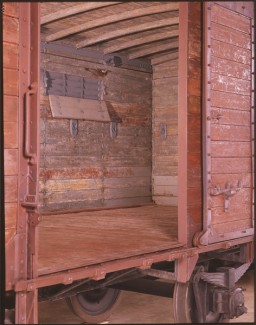
-
Valises by the railcar in the Museum's Permanent Exhibition
ArtifactMany different kinds of railway cars were used for deportations. They varied in size and weight. The railway car on display in the United States Holocaust Memorial Museum's Permanent Exhibition is of just one type used. The dimensions of the railway car in the Museum's exhibition are as follows: Total length 31 feet 6 inches (9.6 meters); interior space for deportees 26 feet 2 inches (8 meters). Total height 14 feet (4.3 meters) from the bottom of the wheel to the highest point of the car; interior space…

-
Warsaw ghetto uprising, 1943
MapThe city of Warsaw is the capital of Poland. Before World War II, Warsaw was the center of Jewish life and culture in Poland. Warsaw's prewar Jewish population of more than 350,000 constituted about 30 percent of the city's total population. The Warsaw Jewish community was the largest in both Poland and Europe, and was the second largest in the world, behind that of New York City. The Germans occupied Warsaw on September 29, 1939. In October 1940, the Germans ordered the establishment of a ghetto in…

-
Germany, 1933
MapWhen Adolf Hitler came to power in January 1933, Germany was potentially one of the strongest powers in Europe. Hitler was determined to overturn the remaining military and territorial provisions of the Treaty of Versailles, which had followed World War I. He aimed to include German-speaking people in the Reich as a preliminary step toward the restoration of German power and the creation of a German empire in Europe. Large numbers of German-speaking people lived in Austria, Czechoslovakia, and Poland.…

-
Portrait of Herschel Grynszpan
PhotoPortrait of Herschel Grynszpan taken after his arrest by French authorities for the assassination of German diplomat Ernst vom Rath. Grynszpan (1921-1943?). Born in Hannover, Germany, was the son of Polish Jews who had immigrated to Germany. In 1936 Grynszpan fled to Paris. On November 7, 1938, after having learned of the expulsion of his parents from Germany to Zbaszyn the Polish frontier, Grynszpan assassinated Ernst vom Rath, the third secretary of the German embassy in Paris. The diplomat's…
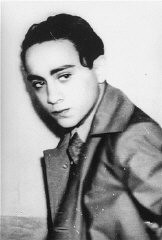
-
Soviet POW camp Belzen bei Bergen
PhotoPhotograph from a series taken by a guard in the Soviet prisoner-of-war camp of Belzen bei Bergen, and numbered in Roman numerals by the American officer, Lt. van Otten. The camp held approximately 10,000 POWs, most of whom came from Fallingbostel, 10 km away. When they fell ill, they were marched to Belsen. At Belsen, they were starved, often given only a soup made of field beets. This photo shows Soviet POWs assembled at the camp. Germany, 1941–45. Second only to the Jews, Soviet prisoners of war…
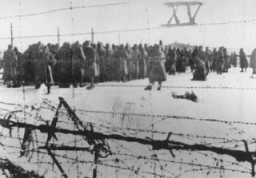
-
"Kristallnacht": nationwide pogrom
MapKristallnacht—literally, "Crystal Night"—is usually translated from German as the "Night of Broken Glass." It refers to the violent anti-Jewish pogrom of November 9 and 10, 1938. The pogrom occurred throughout Germany, which by then included both Austria and the Sudetenland region of Czechoslovakia. Hundreds of synagogues and Jewish institutions all over the German Reich were attacked, vandalized, looted, and destroyed. Many were set ablaze. Firemen were instructed to let the synagogues burn but to…

-
The Hadamar Trial
ArticleThe Hadamar Trial of October 1945 was the first mass atrocity trial held in the US occupation zone of Germany following World War II.

-
Mühldorf
ArticleThe SS established the Mühldorf camp complex in mid-1944 as a satellite system of Dachau to provide labor for the production of the Messerschmitt 262 jet fighter.

-
Ghettos in Occupied Poland
ArticleDuring World War II, the Nazis established ghettos, which were areas of a city where Jews were forced to live. Learn more about ghettos in occupied Poland.

-
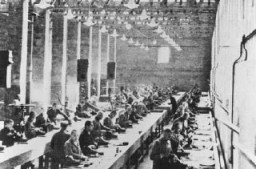
-
The Role of German Clergy and Church Leaders
ArticleTo implement their policies, the Nazis had help from individuals across Europe, including professionals in many fields. Learn about the role of German clergy and church leaders.
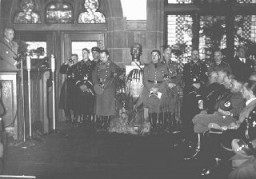
-
"Aryanization"
ArticleBy the process of "Aryanization" in Nazi Germany from 1933 to 1945, Jewish-owned businesses and property were transferred to non-Jews. Learn more.
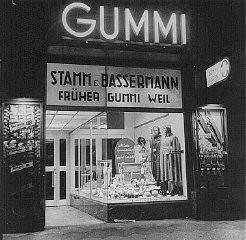
-
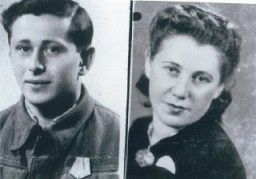
-
Solomon Lapidus
ArticleRead the Jewish Partisan Educational Foundation's short biography of Solomon Lapidus.
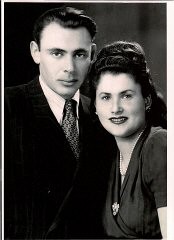
-
Chère Odette
Timeline EventMarch 21, 1942. On this date, while in prison for resistance activities, Charlotte Delbo wrote to her sister. Later deported to Auschwitz, Charlotte would write about her experiences after the war.
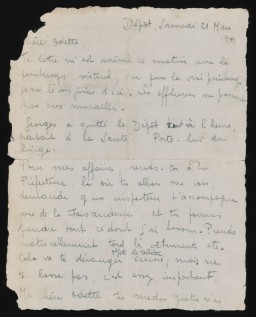
-
Munich Agreement
Timeline EventSeptember 29-30, 1938. On this date, Germany, Italy, Great Britain, and France signed the Munich agreement, giving Germany the Sudetenland.
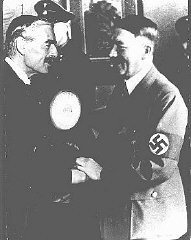
-
The 11th Armored Division during World War II
ArticleThe 11th Armored Division participated in major WWII campaigns and is recognized for liberating Mauthausen and Gusen in 1945.
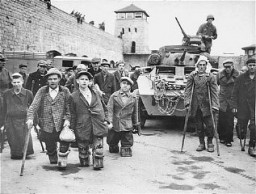
-
Lithuania
ArticleAs part of the Holocaust, the Germans murdered about 90% of Jews in Lithuania. Read more about the tragic experience of Lithuanian Jews during World War II.

-
German and Soviet forces partition Poland
FilmThe German-Soviet Pact of August 1939 included a nonaggression pact whereby Germany and the Soviet Union promised not to attack one another for 10 years. Germany was thus able to invade Poland on September 1, 1939, without fear of Soviet intervention. In accordance with secret provisions of the pact, Poland was partitioned between Germany and the Soviet Union. Soviet forces occupied eastern Poland. In this footage, German and Soviet forces meet along the Bug River in central Poland. Less than two years…
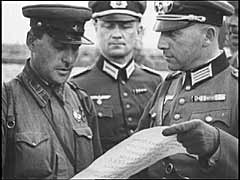
-
World War II: In Depth
ArticleGermany started World War II in Europe on September 1, 1939, by invading Poland. War would continue until 1945. Learn more about key events in the history of WWII.
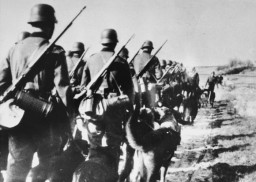
-
Hajj Amin al-Husayni: Arab Nationalist and Muslim Leader
ArticleHajj Amin al-Husayni claimed to speak for the Arab nation and the Muslim world and sought an alliance with the Axis powers during WWII. Learn more about his actions

-
Moringen Youth Camp
ArticleThe Moringen camp was one of the so-called youth protection camps that the Nazi regime established for young people who were alleged to have strayed from Nazi norms and ideals.
-
The Holocaust in Odesa
ArticleIn October 1941, Romania, an ally of Nazi Germany, perpetrated mass killings of Jews in Odesa. Learn more about the Holocaust in Odesa and Ukraine.

